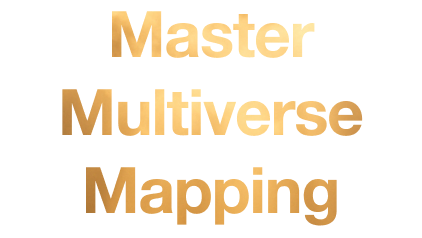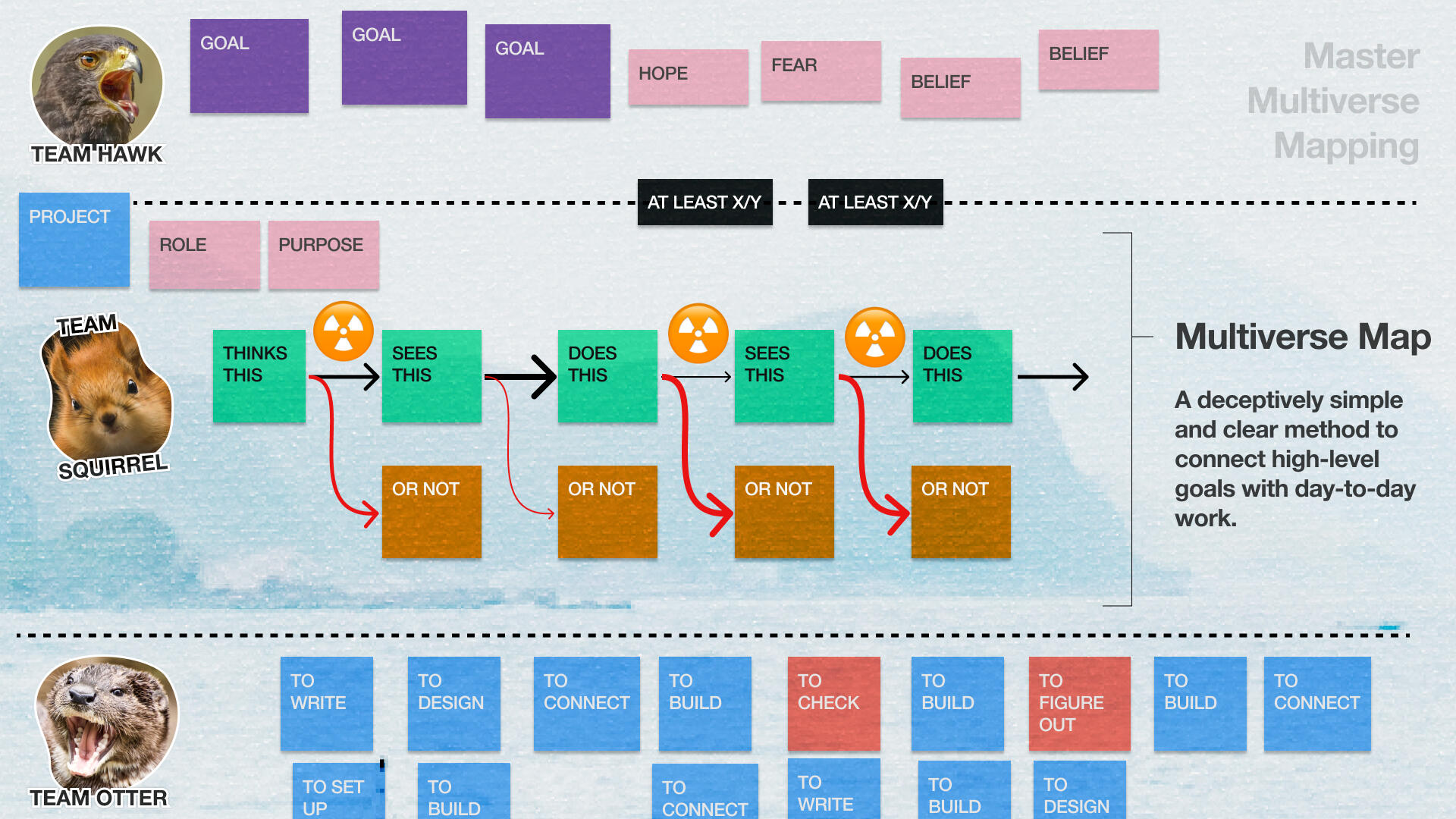
Everyone thinks they're aligned.
So why does the plan still fall apart?
You’ve sat through the meetings.
You’ve prioritised the work.
You’ve done the hard-won extra discovery.Then reality hits, with all its blockers, politics, leadership backflips. And the clarity dissolves into fog.
What if your team could make a shared map that reveals what really has to happen
(and what’s getting in the way)
– in under an hour?
That's what Multiverse Mapping does.
Now you can master the method too.Grab the course now
... or read on to find out more.
Why teams really stay stuck
It’s not because people don’t care.
It’s not because your team lacks talent.
It’s not because you haven’t tried.Most teams get stuck for one simple reason:
They don’t have a shared view of what has to happen — and what might stop it.The blockers stay invisible.
The plan gets fuzzy.
So the team circles, debates, or rushes ahead blindly in the fog.Multiverse Mapping is your fog-cutting tool.
It gives your team one page, one story, one map of what matters — so you can finally move.
Start mapping: £149
Self-paced course
4 hours of structured video
PDF reference toolkit
Email follow ups
Instant access
Get results faster: £499
Course + hands-on help
Everything in the self-paced course
Plus confidential 1:1 expert help on a real project
The quickest path to progress
Clarity Guarantee: If you go through the course and genuinely feel like it didn’t help you cut through the fog, just email within 30 days and you'll be refunded in full. No awkward questions.
Just curious? Join the next free intro session↓ Or learn more about the course ↓
After the course, you’ll be able to:
align teams to take meaningful action ... without debates or trying to persuade people to join a workshop or "kickoff"
prioritise real work to reduce risk rapidly ... without dubious spreadsheet maths or a fictitious impact/effort matrix
plan your work in the way that Pixar plans movies or Frank Gehry plans architecture
hand off work with all the important context included ... without endless presentations and questions
onboard new team members to a project in minutes ... instead of weeks
create momentum in your projects by building confidence ... rather than the momentum of a slow-motion train crash
act and adapt so you can make critical changes while it’s cheap and easy.
A method used by thousands
Over 30,000 intrepid innovators have Multiverse Mapping in their back pocket, courtesy of the Pip Deck Innovation Tactics. It's also been taught to thousands of people in workshops, conferences and training sessions. Refined and improved again and again.

👇 Tap the faces to see what each of these lovely people said about our work
Wait, what's a Multiverse Map?

The heart of the Multiverse Map is in the middle (in green and orange). That’s where you connect the high-level hopes to the daily to-dos and concerns.Making a quick map like this with your team is powerful enough that it’s a no-brainer.And it really gets good when you combine it with other methods. Multiverse Mapping can be used seamlessly with most other project, product and design frameworks: flywheels, stars, trees, journeys…
In the course, you’ll learn:
how to use Multiverse Maps to communicate more strategically
how to slice, prioritise and iterate so you benefit from uncertainty
how to design experiments and research that influence decisions
how to (finally!) figure out the right metrics for any initiative
how to stop those slow-motion-train-crash projects by setting pivot triggers
secret facilitation tips from hundreds of sessions
and more ...
The course includes 4 hours of structured video lessons, packed with examples and guidance, to help you get comfortable with making Multiverse Maps at the drop of a hat. Seriously – these videos will take you from beginner to master mapper. You also get a PDF with notes for every lesson to refer back to when you're in the thick of it.

Meet the only kind of plan that doesn't fall apart on contact with reality
Hello hello, Tom here, the guy behind Multiverse Mapping.Have you ever sat in a meeting thinking “why are we still debating this?” or “this plan doesn't feel real, but I can’t quite say why,” or even "I know this ain't going to work but nobody's going to hit the brakes!"?I know the feeling. That desperation is what drove me to come up with Multiverse Mapping.I’d tried all the fixes ... Strategy decks. PRDs and OKRs. Canvases and North Stars. Assumption Maps and OSTs. Vision workshops. Agile rituals. Personas. Jobs-to-be-Done. Personas-to-be-Jobbed. And the rest.They all help a little. But they don’t stop the chaos.This is the invisible contradiction: we’re trying to build customer-centred products, but we do it by writing internally-facing plans, in tools that customers will never see, based on what we think ought to work.We argue about the right way to do it before we’ve even agreed what “success” looks like (and how success looks different for each person on the team).Pixar wouldn't make a movie that way.Their stories go through 20+ revisions before they hit the screen. But they don’t remake a complete, high-fidelity movie each time they revise it.They storyboard it first. Fast, messy, collaborative. Then they can clearly see the arc of the story they're telling — where it rocks and where it sucks — before it costs millions to change it.Well, Multiverse Mapping is your Pixar storyboard for strategy.It enables your team to sketch a shared story of how success will happen — from a customer behaviours point of view — in under an hour.Then, together, you ask:
“What parts of this story are we most uncertain about?”
“Which behaviours outside our control really matter?”
“What would we be able to see if this story isn’t true?”That’s the shift.It's not just aligning your team.It's de-risking your next move, and designing an intentional path through uncertainty.Because strategy isn’t a document or a deck. It’s a working theory of success that you can test.And that's why this is the only kind of plan that doesn’t fall apart on contact with reality.It’s not a roadmap: it’s a map of the fog you have to move through.It's not prioritisation based on false confidence: it's prioritisation based on the signals you need to feel grounded confidence.And the best bit? You don't need permission to start. This is not a new framework or process you have to persuade people to do.After you take my course, mapping will be something you can just do. Any time you get that tingly sense that you're in the fog, you'll pull out your fog-cutting, bullshit-busting mapping tool.The results will speak for themselves. No more endless alignment debates. No more roadmaps to nowhere. Just grounded, shared momentum.I make a map for almost all my projects, and regret it every time I don’t. I can't wait for you to join me in the Multiverse.Tom x
You don’t need another theoretical framework.
You need a map to point at.
Multiverse Mapping gives you a fast, shared view of what really matters:
What your user needs to see and do in order for you to be successful.
What might stop that from happening.
Where your team’s stories don’t align.
And what we can do about it.
It’s simple, visual, and surprisingly effective.
In under an hour, just by making a map like this one, you'll end the Groundhog Day of debate and confusion, and create clear, directed energy for your team.Not just “alignment”. Momentum.
OPTION A:
Just the video course
£149
4 hours of structured videos, a PDF reference pack, and real-world examples to get you mapping smarter today.
OPTION B:
Course plus 1-on-1 help
£499
Everything in the course — plus 1-on-1 coaching to sharpen your story, test your plan, and show up like a strategy pro.
Clarity Guarantee: If you go through the course and genuinely feel like it didn’t help you cut through the fog, just email within 30 days and you'll be refunded in full. No awkward questions.
Not quite ready, or still have questions?
Join a free Intro to Multiverse Mapping session
In case you think I'm full of it, here's what others have said ...
© Crown & Reach 2025. All rights reserved. No actual fog was harmed in the making of this page.